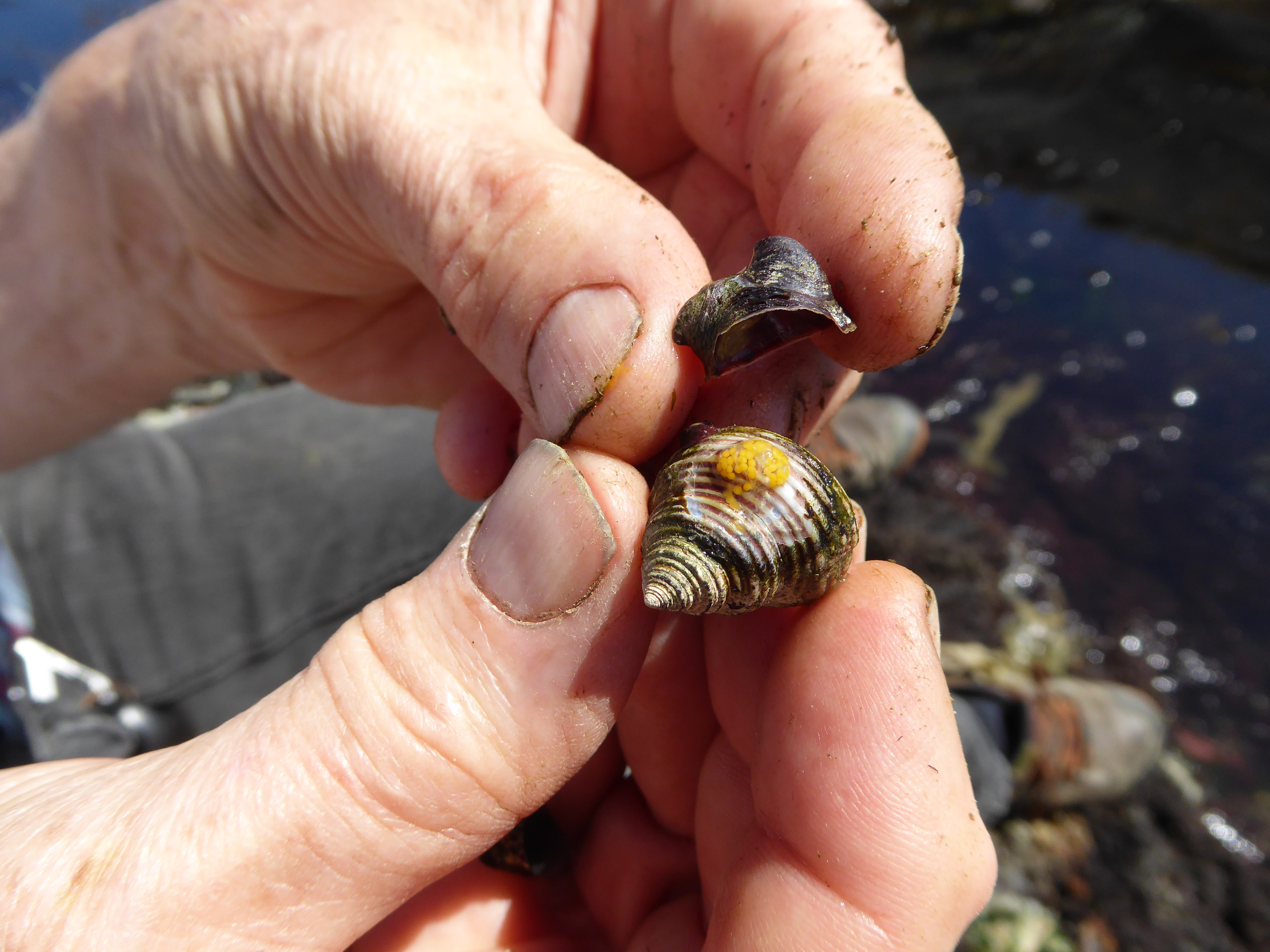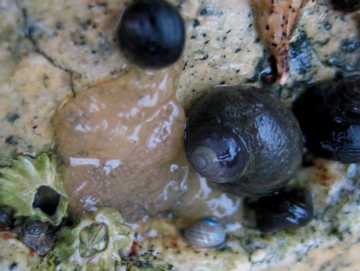
Ocinebrina lurida : Lurid rock snail. The orange snail on the left is probably Ocenebrina. The others are various litorine snails.
Physical description:
Small,size to 1 1/2 ” (38 mm) solid shell with up to 6 whorls; fine close spiral treads crossing 6-10 axial ribs; Oval aperture with 6-7 teeth or more within outer lip height. Shell height most commonly is up to 40 mm, however usually less, with six to ten large low axial ridges crossed by prominent spiral ridges. Colors range from white, pale yellowish, dark brown, or red. It has a canal well developed, and its aperture is oval.
Classification
Domain Eukarya
Kingdom Animalia
Phylum Mollusca
Class Gastropoda
Sub class Prosobranchia
Order Neogastropoda
Family Muricidae
Genus Ocinebrina
Species lurida
Common Name: lurid rock snail
Global Distribution
Ranges from Sitka (Alaska) to Punta Santo Tomas
(Baja California). 57° N- 32° N, in the Pacific Ocean.
Habitat
Low intertidal zones, visible amongst the fucus and other algae at low tide.It is common on and under rocks and in crevices, commonly, clinging to rocks.
Feeding
The lurid rock snail is the natural predator of the giant chiton, Cryptochiton stelleris . It has been observed feeding on gumboot chitons, where it uses its radula to cut through the dark outer layers on the dorsal surface of the chiton’s girdle in order to eat the yellow tissue beneath. They feed on a number of prey items, ranging from bivalves to other gastropods
Reproduction
They have separate sexes. Fertilization of the egg occurs in seawater. Eggs cases are attached to water.
Interesting facts
It may be confused with Amphissa, because its shell shows a similar mixture of fine spiral lines and axial ribs. It’s less slender than Amphissa, its canal is better developed, and its aperture is not at all the shape being oval rather than nearly elliptical. The yellow-brown or orange-brown coloration, and the fact that the axial ribs cross the body whorl, enable one to distinguish it from a small specimen of searlesia. Often confused with larger rock snail, Ocinebrina sclera,
References
http://members.shaw.ca/bcshells/bcframe.html
http://people.www.edu/staff/cowlda/KeyToSpecies/Mollusca/Gastropoda/Prosobranchi/
Order_Neogastropoda/Suborder_Rachiglossa/Family_Muricidae/Ocenebra_lurida.html
Peterson Field Guides Pacific Coast Shells Percy A. Morris Houghton Mifflin Company Boston 2nd edition 1980 Canada
Shells & Shellfish of the Pacific Northwest Rick M. Harbo Harbour Publishing 1997
Other Members of the Phylum Mollusca at Race Rocks.
and Image File |
 The Race Rocks taxonomy is a collaborative venture originally started with the Biology and Environmental Systems students of Lester Pearson College UWC. It now also has contributions added by Faculty, Staff, Volunteers and Observers on the remote control webcams. The Race Rocks taxonomy is a collaborative venture originally started with the Biology and Environmental Systems students of Lester Pearson College UWC. It now also has contributions added by Faculty, Staff, Volunteers and Observers on the remote control webcams. |














